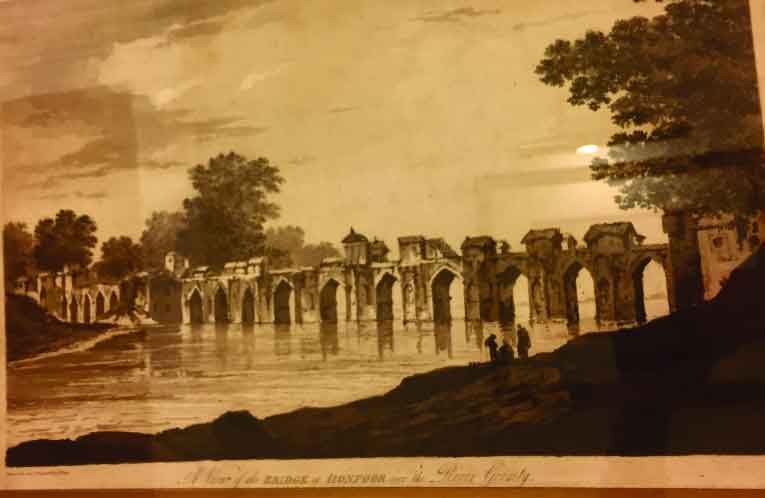A collection of British Raj paintings and aquatints that belongs to the haunts of history can be seen at the hotel which takes you back in time, says Uma Nair
Among Delhi’s hotels the Imperial at Janpath stands tall and alone like a monarch of all precisely because it has a collection of British Raj paintings and aquatints that belong to the haunts of history.
Lord and lady Willingdon
This Hotel was inaugurated in 1936 by Lord Willingdon and Lady Willingdon who named it The Imperial and honoured the hotel with the Insignia or Symbol of a Lion. It became an integral part of the imperial British rule and serviced numerous dignitaries and visitors from England and other countries. The hotel consumed all the Italian marbles of two shops when it was being constructed. Exquisite deco, antique furniture marked by wood carvings and dressed with hand knotted Persian carpets all dating back to the 17th century were bought to decorate it lavishly. A restaurant in this hotel bears the name ‘1911’ to pay tribute to the historical significance of the hotel when the owner was awarded his title and medal during the Coronation of the Durbar in the same year.
British Watercolours and aquatints
The hotel can take you back in history as you look at the paintings from the British Raj which will blow your breath away. It displays historic originals of the works of William Simpson, Thomas Daniells, William Daniells, Charles D’Oyly, William Hodges, John Zollony, J. B. Fraser, James Ferguson and Emily Eden to name a few. It also displays an epic collection of gallantry awards received by Indian, Burmese, Bhutanese, Chinese and Afghanistan soldiers.
Start your tour anywhere — the lobby, the nooks and crannies and crevices — and feast your eyes. While some floors have monochromatic splendours others have coloured spectacles. Among them my favourite belongs to the Himalayan regions as well as a montage that celebrates ‘Hindusthan’. From left to right each element and detail celebrates the iconicity of the true meaning of India both in terms of social as well as ethnic cultural symbolisms. While it carries with it deep nostalgia — it is the accuracy of detailing, the intricate layers of embellishment and the truth to materials and time — that is most evocative in terms of what is poignant and perfection-oriented.
Beauty of Himalayas
Assemblage of Hillmen in the Himalayas and Gungotree, the Holy Shrine of Mahadeo are two of my favourites. If Assemblage of Hillmen has a number of people all dressed identically the Shrine of Mahadeo is a treat for the eyes in terms of detailing and the density of observation and finesse. It was created by James Baillie Fraser (1783-1856). He was the eldest son of a landed Scottish family. He travelled to India and became a merchant in Calcutta in 1814. Whilst in India he studied painting under the tutelage of the eminent artist George Chinnery. He visited the Himalayas in 1815-16 where his brother, William, was the then political agent to Major General Martindell. William was appointed to visit local chiefs in those parts of the Himalayas to the north-west of Garhwal and between the rivers Sutlej and Jumna (Yamuna) in Bashahr and James went with him. During the course of this trip, James reputedly became the first European to reach Gangotri, the source of the Ganges.
Fraser and love for Himalayas
Fraser wrote of the place which is the source of the Ganges, “We were now in the centre of the stupendous Himalayas, the loftiest and perhaps the most rugged range of mountains in the world. We were at the source of that noble river, equally an object of veneration and a source of fertility, plenty and opulence to Hindustan; and we had now reached the holiest shrine of Hindu worship which these holy hills contain.”
In 1815, following the end of the war with Nepal, Fraser and his brother William, spent two months on a tour of the Himalayas. Their journey took the brothers along the river valleys of the Himalayas, with occasional sorties to higher latitudes and as far as the sources of both the Jumna and Ganges rivers.
Gungotree, the Holy Shrine of Mahadeo displays spectacular views of the Himalayas and contains 20 of Havell’s masterly plates worked up from sketches made on the spot by Fraser. In style, the plates are similar to, and very much a match for Henry Salt’s and the Daniel brothers’ large scale views published 10 and 20 years earlier. This was a deliberate strategy by the publishers who drew attention to the similarities in their advertisements which describe the work as being uniform with Daniell’s Oriental Scenery, and Salt’s Views in Abyssinia.
Leaves of history:
The Imperial Hotel dates back to 1934 with the inception of a concept to build a colonial style hotel in India by Bloomfield along with the financial support of Rai Bahadur Sardar Narain Singh who was responsible for building the Patiala Tunnel on the orders of the Maharaja of Patiala, building the city of Dehradun, Mussoorie and spiritual centres in Rishikesh and Hardwar. He was also commissioned to build the Doon School, Prince of Wales College, Forest Research Institute of India including all the bridges seen today in the valley. After completion of these prestigious assignments, R B S Singh was also awarded the contract to construct the road to Koeta and the Sirhind Canal. Pleased with his work, King George V and Empress Queen Mary made a mention of it when they visited Delhi to lay the foundation stone of New Delhi on December 12, 1911. Major Crookshank then awarded a Certificate of Recognition to Singh including the title of ‘Rai Sahib’ and a ‘Durbar Medal’ for all impeccable work completed by him.


























